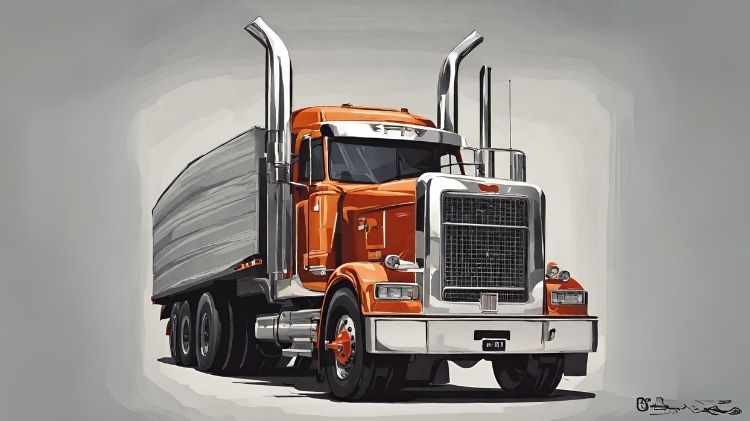Clearing the View: How Side Mirrors Improve Your Truck’s Visibility
Introduction to Side Mirrors
Trucks are the lifeblood of many industries, transporting goods across vast distances and keeping economies moving. However, their sheer size and weight also pose significant challenges, especially when it comes to visibility on the road. This is where side mirrors step in as unsung heroes, offering truck drivers crucial assistance in navigating safely through traffic.
At their core, side mirrors serve as the eyes on the sides of a truck, providing drivers with essential visibility beyond what they can see through the windshield. They expand the driver’s field of view, reducing blind spots and alerting them to any potential hazards lurking in adjacent lanes. Whether it’s a merging vehicle, a cyclist on the side, or a pedestrian crossing, side mirrors offer a vital perspective that can mean the difference between a smooth journey and a dangerous accident.
But it’s not just about avoiding collisions; side mirrors also play a fundamental role in enhancing overall road awareness. By constantly scanning their mirrors, drivers can stay informed about the traffic around them, making better decisions and reacting promptly to changing situations. This heightened situational awareness is particularly crucial for truck drivers, who must contend with longer stopping distances and limited maneuverability.
In essence, side mirrors are more than just reflective surfaces—they’re indispensable tools for truck drivers, empowering them to navigate safely through the complexities of the road. In the chapters that follow, we’ll delve deeper into the various aspects of side mirrors, exploring their types, functions, maintenance, and the legal requirements surrounding their use. So buckle up as we embark on a journey to uncover the importance of side mirrors in improving your truck’s visibility and safety on the road.
Types of Side Mirrors
Side mirrors come in a variety of types, each designed to cater to different needs and preferences of truck drivers. Understanding these variations is essential for selecting the most suitable side mirrors for your truck. Here’s a breakdown of the common types:
Manual Side Mirrors:
These are the traditional type of side mirrors that are adjusted manually by the driver from inside the vehicle. While simple in design, manual side mirrors provide basic functionality and are often found in entry-level truck models.
Electric Side Mirrors:
Electric side mirrors offer the convenience of remote-controlled adjustment. With the push of a button inside the truck cabin, drivers can effortlessly adjust the position of their side mirrors, enhancing convenience and comfort, especially for frequent adjustments.
Heated Side Mirrors:
In colder climates, ice and frost accumulation on side mirrors can impair visibility, posing a safety risk. Heated side mirrors feature built-in heating elements that help prevent ice buildup, ensuring clear visibility even in freezing conditions.
Towing Mirrors:
Designed for trucks towing trailers or other large loads, towing mirrors offer extended reach and wider angles of view to accommodate the increased width and length of the load. These mirrors are essential for maintaining visibility and safety while towing.
By understanding the differences between these types of side mirrors, truck drivers can make informed decisions when choosing the right mirrors for their specific needs. Whether prioritizing convenience, functionality, or specialized requirements like towing, there’s a side mirror option available to enhance visibility and safety on the road.
Importance of Proper Adjustment
Properly adjusting your side mirrors is paramount to maximizing their effectiveness in enhancing visibility and safety on the road. Unfortunately, many drivers overlook this crucial step, leading to blind spots and potentially hazardous situations. In this chapter, we’ll delve into the importance of correctly adjusting your side mirrors and provide step-by-step instructions to ensure optimal visibility.
Eliminating Blind Spots:
One of the primary purposes of side mirrors is to eliminate blind spots, areas around the vehicle that are not visible to the driver through the rearview or side mirrors. By adjusting the side mirrors outward, drivers can minimize blind spots and maintain continuous visibility of adjacent lanes.
Achieving Proper Angle and Position:
To effectively eliminate blind spots, side mirrors should be angled outward to capture the maximum field of view without overlapping with the rearview mirror’s coverage. The side mirrors should be positioned so that the side of the vehicle is barely visible, ensuring that they capture the widest possible view of the surrounding traffic.
Regular Adjustment:
Side mirrors can become misaligned over time due to vibrations, impacts, or changes in driving habits. Therefore, it’s essential to periodically check and readjust the mirrors to maintain optimal visibility. This is especially important when switching drivers or towing trailers, as the mirror settings may need to be customized for each driver or scenario.
Utilizing Additional Features:
Many modern vehicles are equipped with advanced mirror adjustment features, such as power folding mirrors or memory settings. Drivers should take advantage of these features to customize their mirror positions for different driving conditions or parking situations, further enhancing convenience and safety.
By taking the time to properly adjust your side mirrors, you can significantly improve your visibility on the road, reduce the risk of accidents, and ultimately drive with greater confidence and peace of mind.
Enhancing Visibility in Different Conditions
Side mirrors play a crucial role in enhancing visibility for truck drivers, especially in various challenging driving conditions. In this chapter, we’ll explore how side mirrors contribute to improved visibility in different scenarios and provide tips for using them effectively.
Bad Weather:
During inclement weather conditions such as rain, fog, or snow, visibility can be significantly reduced, making it challenging to see surrounding vehicles and obstacles. Side mirrors help compensate for limited visibility by providing additional vantage points, allowing drivers to monitor their surroundings more effectively.
Low Light Conditions:
Driving at night or in low light conditions presents its own set of visibility challenges. Side mirrors equipped with reflective coatings or integrated lights can help improve visibility by enhancing the reflection of incoming headlights and increasing the driver’s awareness of vehicles approaching from behind.
Heavy Traffic:
In congested traffic situations, side mirrors are invaluable for monitoring adjacent lanes and detecting potential hazards, such as lane changes or merging vehicles. By regularly scanning their side mirrors, drivers can anticipate traffic movements and react promptly to avoid accidents or delays.
Narrow Roads and Tight Spaces:
When navigating narrow roads or maneuvering in tight spaces, side mirrors provide essential guidance for maintaining proper positioning and avoiding collisions with obstacles such as curbs, parked vehicles, or structures. Adjusting the side mirrors to provide a wider field of view can help drivers navigate these challenging environments with confidence.
Off-Road Conditions:
For trucks venturing off-road or onto unpaved surfaces, side mirrors help drivers navigate rugged terrain and uneven landscapes by providing visibility of potential obstacles and hazards outside the vehicle’s immediate path.
By leveraging the benefits of side mirrors in various driving conditions, truck drivers can enhance their visibility, anticipate potential risks, and ultimately drive more safely and confidently regardless of the challenges they encounter on the road.
Maintenance and Care
Maintaining and caring for your truck’s side mirrors is essential to ensure their optimal functionality and longevity. Neglecting proper maintenance can lead to reduced visibility, malfunctions, and even safety hazards. In this chapter, we’ll discuss the importance of regular maintenance and provide practical tips for keeping your side mirrors in top condition.
Cleaning:
Regularly clean your side mirrors to remove dirt, dust, and grime that can accumulate on the reflective surface. Use a mild detergent solution and a soft cloth to gently wipe the mirrors clean, avoiding abrasive materials that could scratch or damage the glass.
Adjustments:
Periodically check and readjust your side mirrors to ensure they remain properly aligned and provide optimal visibility. Vibrations from driving or impacts from debris can cause the mirrors to shift out of position, compromising their effectiveness.
Inspection:
Inspect your side mirrors for any signs of damage, such as cracks, chips, or loose components. Addressing issues promptly can prevent further damage and ensure that the mirrors function correctly when you need them most.
Lubrication:
If your side mirrors feature moving parts or electronic components, lubricate them regularly to prevent friction and ensure smooth operation. Use a silicone-based lubricant recommended by the manufacturer to maintain optimal performance.
Protection:
Protect your side mirrors from potential damage by parking in designated areas away from high-traffic areas or tight spaces where they could be clipped by passing vehicles. Consider installing protective covers or guards to shield the mirrors from impacts and environmental hazards.
By incorporating these maintenance practices into your regular routine, you can extend the lifespan of your truck’s side mirrors and ensure that they continue to provide reliable visibility and safety on the road.
Upgrading Your Side Mirrors
Innovation in automotive technology has led to the development of advanced side mirror systems that offer enhanced functionality and safety features. In this chapter, we’ll explore the benefits of upgrading your side mirrors and discuss the various options available to modernize your truck’s visibility.
Blind-Spot Monitoring:
Many newer vehicles are equipped with blind-spot monitoring systems that use sensors to detect vehicles in the driver’s blind spots and alert them with visual or auditory warnings. Upgrading to side mirrors with integrated blind-spot monitoring can provide an additional layer of safety by alerting drivers to potential hazards they may have missed.
Integrated Cameras:
Some side mirrors feature integrated cameras that provide a live feed of the vehicle’s surroundings, offering a comprehensive view of blind spots and potential obstacles. These camera systems can be particularly useful for maneuvering in tight spaces or when towing trailers, allowing drivers to see areas that would otherwise be out of view.
Automatic Adjustment:
Advanced side mirror systems can automatically adjust their position based on driving conditions, such as vehicle speed or steering input. This feature ensures that the mirrors provide optimal visibility at all times, reducing the need for manual adjustments and enhancing convenience for the driver.
Heated and Defrosting Mirrors:
For drivers in colder climates, upgrading to side mirrors with built-in heating elements can help prevent ice and frost buildup, ensuring clear visibility even in freezing conditions. These heated mirrors can significantly improve safety by maintaining visibility during inclement weather.
Power Folding Mirrors:
Power folding mirrors can be automatically folded inward at the touch of a button, reducing the risk of damage when parking in tight spaces or navigating narrow passages. This feature adds convenience and peace of mind for drivers, especially in urban environments where space is limited.
By upgrading to advanced side mirror systems with these innovative features, truck drivers can enhance their visibility, safety, and overall driving experience on the road.
Legal Requirements and Regulations
Understanding the legal requirements and regulations surrounding side mirrors for trucks is essential for ensuring compliance and promoting road safety. In this chapter, we’ll explore the laws governing side mirrors and highlight the importance of adhering to these regulations.
Minimum Number of Mirrors:
Many jurisdictions mandate the minimum number of side mirrors required for trucks to be considered roadworthy. These requirements typically specify the number of mirrors needed and their placement on the vehicle to provide adequate visibility for the driver.
Visibility Standards:
In addition to the minimum number of mirrors, there are often regulations dictating the visibility standards that side mirrors must meet. This includes specifications regarding the size, curvature, and reflective properties of the mirrors to ensure clear and unobstructed visibility for the driver.
Towing and Trailer Requirements:
Trucks towing trailers or other large loads may be subject to additional mirror requirements to accommodate the increased width and length of the load. These regulations may specify the use of extended mirrors or supplementary mirror attachments to provide sufficient visibility while towing.
Inspection and Enforcement:
Authorities conduct regular inspections to ensure that vehicles comply with side mirror regulations, and non-compliance can result in fines or penalties. It’s essential for truck drivers and fleet operators to stay informed about the relevant laws and ensure that their vehicles meet the necessary requirements to avoid legal consequences.
Safety Implications:
Complying with side mirror regulations isn’t just about avoiding fines—it’s also about prioritizing safety on the road. Properly positioned and maintained side mirrors are critical for enhancing visibility and reducing the risk of accidents, making adherence to legal requirements a crucial aspect of responsible driving.
By understanding and adhering to the legal requirements and regulations governing side mirrors, truck drivers can help promote road safety and ensure that their vehicles are compliant with the law.
Conclusion
In the journey of exploring how side mirrors improve your truck’s visibility, we’ve uncovered the fundamental role these essential components play in ensuring safety on the road. From providing a wider field of view to eliminating blind spots, side mirrors are indispensable tools for truck drivers navigating through various driving conditions.
By understanding the different types of side mirrors available, learning how to properly adjust and maintain them, and exploring advanced features like blind-spot monitoring and integrated cameras, drivers can significantly enhance their visibility and awareness on the road.
Moreover, adhering to legal requirements and regulations regarding side mirrors is not only a legal obligation but also a vital step in promoting road safety for all. Compliance with these regulations ensures that trucks are equipped with the necessary visibility aids to minimize the risk of accidents and ensure the safety of drivers, passengers, and other road users.
As technology continues to evolve, we can expect further innovations in side mirror systems, offering even more advanced features to enhance visibility and safety. By staying informed about these advancements and embracing new technologies, truck drivers can continue to prioritize safety and efficiency in their journeys on the road.
In conclusion, side mirrors are more than just reflective surfaces—they’re essential components that empower truck drivers to navigate safely and confidently through the complexities of the road. By recognizing their importance and investing in their maintenance and enhancement, drivers can ensure a clear view ahead and a safer journey for everyone.
For detailed information, you can contact us at Truck Mirrors


